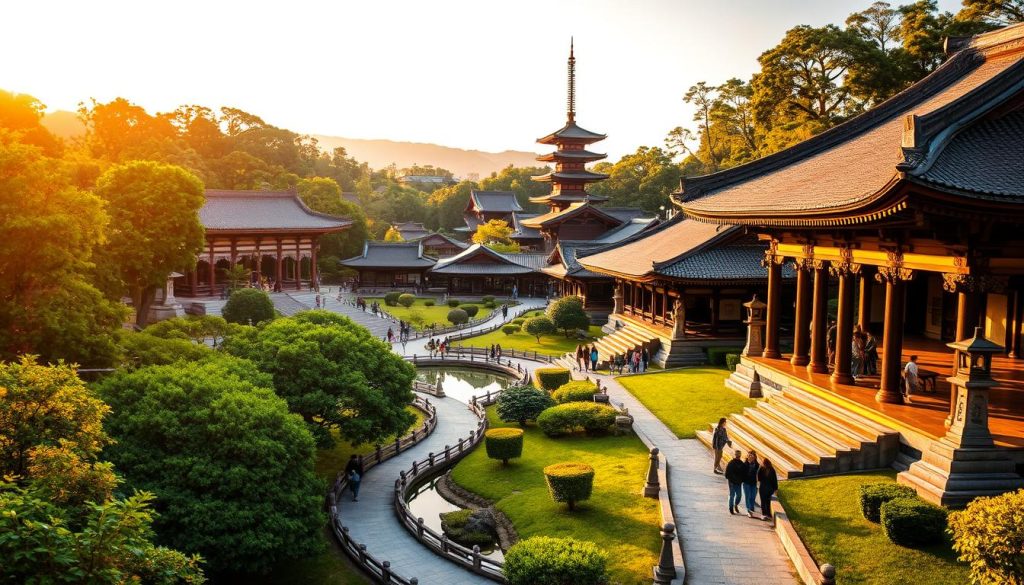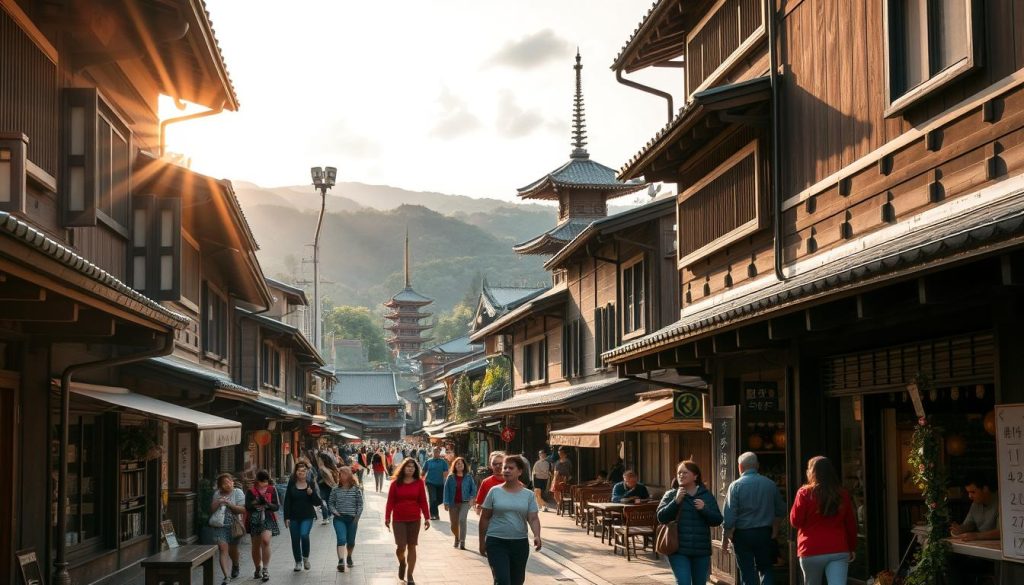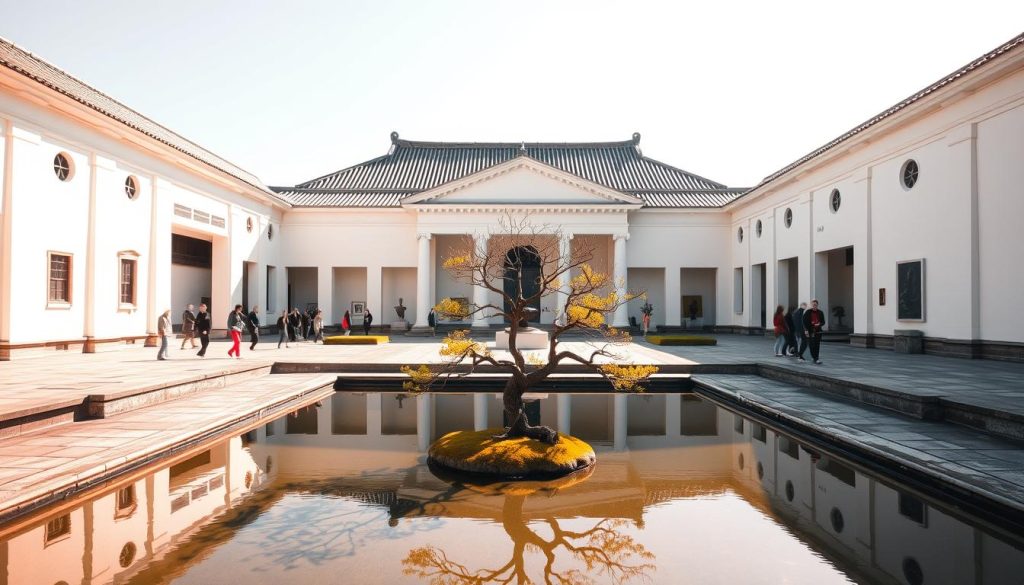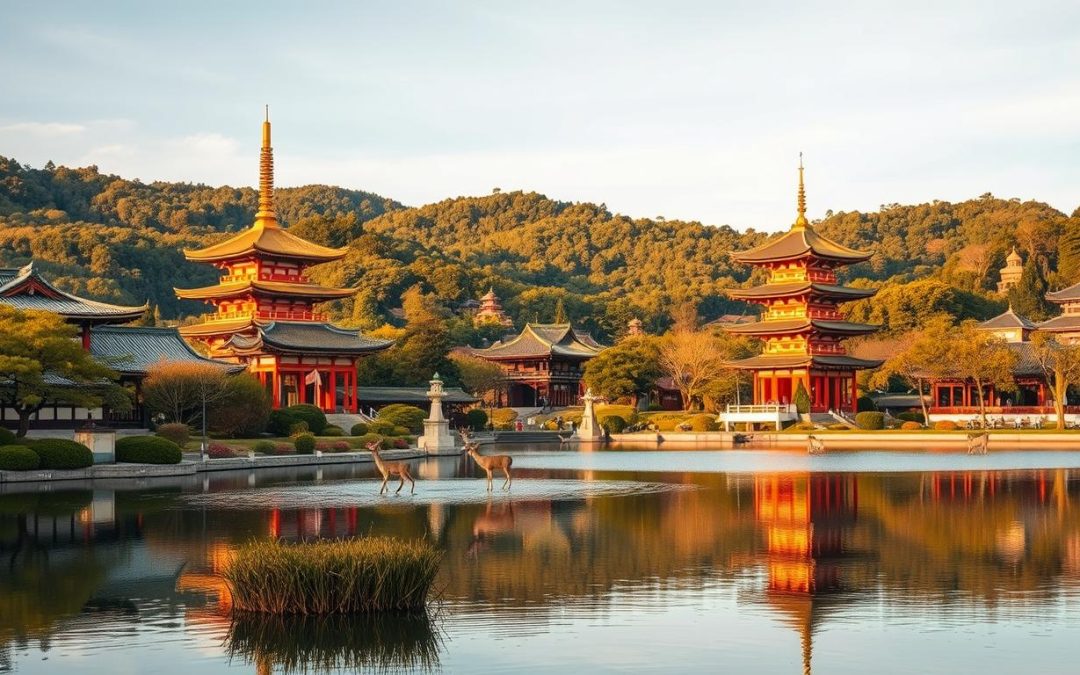Have you ever wondered what it would be like to step into a place where history and nature coexist seamlessly? This city offers just that, blending ancient traditions with modern charm. Known for its iconic deer and world-renowned landmarks, it’s a destination that invites you to explore its unique cultural heritage.
From majestic temples to serene parks, this city is a treasure trove of experiences. Whether you’re marveling at the grandeur of its historic sites or feeding friendly deer in the park, every moment here feels like a journey through time. This guide will help you uncover the top picks that make this place unforgettable.
Key Takeaways
- Discover a city where ancient traditions meet modern convenience.
- Explore iconic temples and shrines that tell stories of the past.
- Interact with sacred deer that roam freely in the park.
- Experience a blend of cultural and natural attractions.
- Plan your visit with this friendly guide to the top picks.
Getting Started in Nara: Planning Your Adventure
Ready to explore a destination where ancient traditions come alive? This city, known for its rich heritage, offers a seamless blend of history and nature. From sacred temples to serene parks, every corner tells a story. Let’s help you plan your adventure so you can make the most of your visit.
Overview of Nara’s Rich Heritage
This area was once the capital of Japan, established in the year 710. Its historical significance is evident in its well-preserved cultural sites. The city is home to iconic landmarks like the Great Buddha Hall, the largest wooden structure in the world. Walking through the streets feels like stepping back in time.
Many attractions are within walking distance, making it easy to explore. Whether you’re visiting a temple or strolling through the park, you’ll feel connected to the past. The area’s layout is designed to immerse you in its history.
Essential Travel Tips for U.S. Visitors
Planning your trip is simple. The best time to visit is during spring or autumn when the weather is pleasant, and the scenery is stunning. Spring brings cherry blossoms, while autumn offers vibrant fall foliage.
Getting here is easy, with train options from Kyoto and Osaka. Once you arrive, many sites are accessible by foot. Wear comfortable shoes, as you’ll be walking a lot. Don’t forget to check the opening hours of temples and parks to plan your day efficiently.
This city welcomes visitors with open arms. With a little preparation, your adventure will be smooth and memorable.
Exploring Nara’s Historic Temples and Shrines
Step into a world where ancient traditions and spiritual wonders come alive. This city is home to some of the most iconic temples and shrines, each telling a story of its rich past. From the towering Great Buddha to the enchanting lantern-lined paths, these sites offer a glimpse into centuries of history and culture.

Tōdai-ji Temple and the Great Buddha Experience
One of the most remarkable sites is Tōdai-ji Temple. This architectural marvel houses the Great Buddha, a bronze statue standing at an impressive 15 meters tall. The temple itself is the largest wooden structure in the world, a testament to the craftsmanship of its builders.
Walking through the temple’s grand gates, you’ll feel a sense of awe. The Great Buddha, with its serene expression, has watched over the city for centuries. It’s a must-see for anyone interested in history and spirituality.
The Charm of Kasuga Taisha’s Lantern-Lined Path
Another highlight is Kasuga Taisha, a shrine known for its thousands of stone lanterns. Established in 768 AD, this site is a visual feast. The lanterns line the path to the shrine, creating a magical atmosphere, especially during festivals when they are lit.
As you stroll along the path, you’ll notice intricate carvings and ancient scrolls that add to the shrine’s charm. It’s a place where history and beauty come together, offering a peaceful retreat from the modern world.
| Feature | Tōdai-ji Temple | Kasuga Taisha |
|---|---|---|
| Main Attraction | Great Buddha Statue | Lantern-Lined Path |
| Historical Significance | Largest wooden structure | Established in 768 AD |
| Unique Experience | Serene Buddha statue | Magical lantern displays |
“Every stone and statue here whispers stories of the past, inviting you to listen and learn.”
These temples and shrines are more than just landmarks; they are windows into a bygone era. Take your time to explore and appreciate the artistry and devotion that went into creating these spiritual sanctuaries.
Discovering the Magic of Nara Deer Park
Imagine walking through a serene landscape where friendly deer roam freely. This is the experience that awaits you at Nara Park, a place where nature and wildlife come together in harmony. The park’s lush greenery and peaceful atmosphere make it a must-visit destination.
The deer here are not just animals; they are considered sacred in Shintō traditions. For centuries, they have been protected as messengers of the gods. This cultural significance adds a unique layer to your visit, making it more than just a walk in the park.
How to Safely Interact with the Famous Deer
While the deer are friendly, they are still wild animals. Here are some tips to ensure a safe and enjoyable experience:
- Feed them carefully: You can buy special deer crackers available in the park. Hold them out flat in your hand to avoid accidental nibbles.
- Respect their space: Avoid sudden movements or loud noises that might startle them.
- Stay aware: Keep an eye on your belongings, as deer are curious and might try to investigate bags or food.
For the best experience, head to the scenic slopes and hills within the park. These areas offer stunning views and are perfect for observing the deer in their natural habitat. Don’t forget to bring your camera to capture these unforgettable moments.
| Spot | Highlight |
|---|---|
| Main Park Area | High deer population, ideal for feeding and interaction |
| Scenic Slopes | Beautiful views, quieter deer encounters |
| Nearby Hills | Perfect for photography and peaceful walks |
“The deer of Nara Park are more than just animals; they are a living connection to centuries of tradition and culture.”
Whether you’re feeding the deer or simply enjoying the park’s natural beauty, Nara Park offers a one-of-a-kind experience. Take your time to explore and immerse yourself in this enchanting environment.
A Cultural Journey Through Nara-machi and Local Streets
Take a stroll through Nara-machi, where history whispers through every cobblestone. This charming district, once a bustling merchant hub, now offers a glimpse into the city’s rich heritage. As you wander its narrow alleys, you’ll discover preserved merchant houses, hidden museums, and a blend of past and present that feels timeless.

Traditional Merchant District and Hidden Museums
Nara-machi’s traditional merchant district is a treasure trove of cultural gems. Centuries-old family businesses still operate here, their architecture reflecting the craftsmanship of a bygone era. The district’s preserved houses, with their wooden lattices and tiled roofs, tell stories of a thriving community that once thrived in this area.
Hidden within these streets are small museums that showcase local art and history. These spaces offer a deeper understanding of the city’s heritage, from ancient artifacts to contemporary works. Each museum is a treasure waiting to be discovered, inviting you to connect with the stories of the past.
| Feature | Merchant District | Hidden Museums |
|---|---|---|
| Highlights | Preserved houses, family businesses | Local art, historical artifacts |
| Experience | Walk through history | Discover cultural treasures |
| Atmosphere | Timeless charm | Quiet and reflective |
“Nara-machi is more than a place; it’s a living museum where every corner holds a piece of history.”
As you meander through the quaint alleys, you’ll find yourself immersed in authentic local experiences. Whether it’s sipping tea in a traditional shop or admiring the intricate details of a merchant house, Nara-machi offers a unique blend of history and culture. This area is a testament to the city’s enduring legacy, inviting you to explore and connect with its heritage.
Nara Prefecture, Japan: Best Things to Do – Top Picks
Discover a destination where history and culture intertwine effortlessly. This city is home to iconic landmarks that have stood the test of time. From grand temples to serene shrines, each site offers a glimpse into a rich past. These attractions are not just places to visit; they are experiences that connect you to centuries of heritage.
Why These Sites Are a Must-See
These world heritage sites are more than just beautiful. They are integral to understanding the city’s identity. Each location tells a story of craftsmanship, devotion, and history. Visiting these sites is like stepping into a living museum, where every stone and statue has a tale to share.
Planning your trip around these attractions ensures you capture the essence of this unique destination. Whether you’re marveling at ancient architecture or exploring sacred grounds, these sites will leave a lasting impression.
Top Picks for Your Itinerary
Here are some of the most iconic sites you shouldn’t miss:
- Tōdai-ji Temple: Home to the Great Buddha, this temple is a marvel of wooden architecture.
- Kasuga Taisha: Known for its lantern-lined paths, this shrine is a visual delight.
- Nara Park: A serene landscape where sacred deer roam freely.
| Site | Highlight | Historical Significance |
|---|---|---|
| Tōdai-ji Temple | Great Buddha Statue | Largest wooden structure in the world |
| Kasuga Taisha | Lantern Displays | Established in 768 AD |
| Nara Park | Sacred Deer | Cultural symbol of Shintō traditions |
“These sites are not just landmarks; they are windows into a world where history comes alive.”
Each of these attractions offers a unique experience, blending history, culture, and natural beauty. Make sure to include them in your itinerary for a trip that captures the grandeur of the past and the vibrancy of the present.
Experiencing Spiritual Heritage at Nigatsu-dō
Experience a place where spirituality meets breathtaking views at Nigatsu-dō. This historic site, part of the Tōdai-ji complex, is a sanctuary of peace and reflection. Its elevated location offers panoramic vistas that will leave you in awe, making it a must-visit for anyone seeking a deeper connection to the past.
The spiritual ambiance here is palpable. As you walk through the temple grounds, you’ll feel a profound sense of history and devotion. Nigatsu-dō is not just a place to visit; it’s a journey into the heart of ancient traditions.
Panoramic Views and the Omizutori Festival
One of the highlights of Nigatsu-dō is its scenic balcony. From here, you can take in sweeping views of the surrounding landscape. It’s a perfect spot to pause and reflect, especially during the Omizutori Festival, held annually in March.
This festival marks the beginning of a new year in the lunar calendar. It’s a time of renewal, where ancient rituals honor the deities and celebrate cultural heritage. The festival’s torchlight processions and water-drawing ceremonies are mesmerizing, offering a glimpse into centuries-old traditions.
“The Omizutori Festival is a reminder of the enduring power of faith and the beauty of shared rituals.”
To make the most of your visit, plan your trip around the festival dates. Arrive early to secure a good viewing spot and take time to explore the temple’s intricate details. Whether you’re here for the views or the spiritual experience, Nigatsu-dō promises an unforgettable journey through time.
Architectural Wonders: Kōfuku-ji and Edo Period Rebuilds
Step into a world where architectural brilliance meets centuries of history. Kōfuku-ji, a stunning temple complex, stands as a testament to the artistry and devotion of its creators. Its towering pagodas and historic halls are more than just buildings; they are windows into a rich cultural past.
One of the highlights is the five-story pagoda, standing at 50 meters tall. It’s the second tallest wooden pagoda in the country, a marvel of ancient engineering. The temple’s design reflects the elegance of its time, with intricate details that captivate visitors.
Insights into Historical Restoration and Artistry
During the Edo period, many parts of Kōfuku-ji were rebuilt, preserving its grandeur for future generations. Skilled artisans used traditional techniques to restore objects and scrolls, ensuring their survival. These efforts have allowed us to appreciate the craftsmanship of the past.
Restoration wasn’t just about repairing structures; it was about reviving the spirit of the temple. Every detail, from the carvings to the paintings, tells a story of dedication and skill. The Edo period rebuilds have shaped the modern appearance of this historic site, blending old and new seamlessly.
“The restoration of Kōfuku-ji is a celebration of heritage, where every stroke of the brush and chisel honors the past.”
| Feature | Kōfuku-ji | Edo Period Rebuilds |
|---|---|---|
| Main Attraction | Five-story pagoda | Restored halls and objects |
| Historical Significance | Second tallest wooden pagoda | Preservation of cultural heritage |
| Unique Experience | Architectural brilliance | Blend of old and new |
Visiting Kōfuku-ji is more than a trip to a temple; it’s a journey through time. The buildings and their restored parts invite you to appreciate the artistry and history that define this iconic site. It’s a place where the past comes alive, offering a glimpse into the cultural heritage of the city.
Immersing Yourself in Art at Nara National Museum
Dive into a world where art and spirituality converge in one remarkable space. The Nara National Museum is a cultural treasure, housing an extensive collection of Buddhist art. From ancient statues to delicate scrolls, every exhibit tells a story of devotion and creativity.

Established in 1895, this museum is Japan’s second-oldest national institution. Its buildings are as impressive as the artifacts they house, blending traditional architecture with modern preservation techniques. Here, you’ll find a treasure trove of history waiting to be explored.
The museum’s permanent collection includes stunning Buddha statues, intricate carvings, and ceremonial objects. These pieces offer a glimpse into the spiritual and artistic traditions of the past. Special exhibits often highlight rare scrolls and artifacts, making each visit unique.
“The Nara National Museum is more than a repository of art; it’s a gateway to understanding Japan’s spiritual heritage.”
One of the highlights is the East Wing, which focuses on Buddhist art from the region. The exhibits are thoughtfully curated, providing context and insight into each piece. Whether you’re an art enthusiast or a history buff, the museum offers something for everyone.
| Feature | Permanent Collection | Special Exhibits |
|---|---|---|
| Highlights | Buddha statues, carvings | Rare scrolls, artifacts |
| Experience | Deep dive into history | Unique, rotating displays |
| Atmosphere | Serene and reflective | Dynamic and engaging |
Visiting the museum is a journey through time. It’s a place where the past comes alive, inviting you to connect with Japan’s rich cultural legacy. Don’t miss this opportunity to immerse yourself in the beauty and history of Buddhist art.
Serene Gardens: Isui-en and Yoshikien Escapes
Find peace in the heart of meticulously designed landscapes. Isui-en and Yoshikien gardens are tranquil retreats that offer a perfect blend of nature and artistry. These historic spaces invite you to slow down and soak in their serene beauty.
Tea Houses, Ponds, and Tranquil Walks
Isui-en and Yoshikien are more than just gardens; they are experiences. Stroll through their meticulously designed landscapes, where every path leads to a new discovery. The gardens feature charming tea houses and reflective ponds that invite you to pause and relax.
Isui-en, with its two distinct sections, offers a journey through time. The front garden dates back to the Edo period, while the back garden reflects the Meiji era. Yoshikien, on the other hand, is a smaller but equally enchanting space, often less crowded and perfect for quiet reflection.
Here’s what makes these gardens special:
- Tea Houses: Enjoy a moment of calm with a traditional tea ceremony.
- Reflective Ponds: These water features add a sense of harmony and tranquility.
- Scenic Walks: Meander through paths lined with lush greenery and seasonal blooms.
“These gardens are not just places to visit; they are sanctuaries where the soul finds peace.”
Whether you’re seeking a quiet escape or a deeper connection to Japanese aesthetics, Isui-en and Yoshikien provide the perfect setting. Take your time to explore and let the natural beauty of these gardens inspire you.
Navigating Nara: Transportation Tips and Routes
Getting around Nara is a breeze, thanks to its well-connected train routes and convenient stops. Whether you’re coming from Kyoto, Osaka, or Tokyo, the city is easily accessible, making it a stress-free destination for your trip. With a little planning, you can explore all the highlights without a hitch.

Train Options from Kyoto, Osaka, and Tokyo
If you’re starting your journey in Kyoto or Osaka, the Kintetsu and JR lines are your best way to reach Nara. Both offer frequent departures, with travel times under an hour. From Tokyo, the shinkansen (bullet train) to Kyoto, followed by a local train, is the most efficient way to get here.
For those with a JR Pass, you can enjoy unlimited travel on JR lines, including the shinkansen. Without the pass, the Kintetsu line is a cost-effective alternative. Both options bring you to Nara’s central stop, just a short walk from major attractions.
Here are some tips to make your journey smoother:
- Plan your route: Use apps like Google Maps or Hyperdia to check schedules and connections.
- Arrive early: Trains can get crowded during peak hours, so give yourself extra time.
- Bring cash: While IC cards like ICOCA or Suica are convenient, some rural stops may require cash for tickets.
Once you arrive, Nara’s compact layout makes it easy to explore on foot. Many attractions, like Tōdai-ji Temple and Nara Park, are within walking distance of the train station. For farther sites, local buses are a reliable way to get around.
“Traveling by train in Nara is not just efficient; it’s a chance to enjoy the scenic beauty of the region.”
With these tips, your trip to Nara will be smooth and enjoyable. Whether you’re here for a day or longer, the city’s transportation system ensures you’ll make the most of your time in this historic place.
Local Festivals and Traditional Celebrations
Step into a world where ancient traditions come alive through vibrant festivals and timeless celebrations. These events are a part of the cultural fabric, blending religious rituals with communal joy. They offer a unique way to connect with the heritage of this historic region.
Omizutori and Wakakusa Yamayaki Fire Festivals
The Omizutori festival, held every March, is one of the most significant events in the area. Rooted in Buddhist traditions, it marks the drawing of sacred water from a temple well. The highlight is the torchlight procession, where flames illuminate the night, symbolizing purification and renewal.
Another iconic event is the Wakakusa Yamayaki festival, held in January. This fiery celebration involves setting a hillside ablaze, creating a breathtaking spectacle. It’s a communal event that brings locals and visitors together, celebrating the start of a new year.
Here’s what makes these festivals special:
- Historical Roots: Both events date back centuries, preserving ancient customs.
- Cultural Significance: They blend religious practices with community bonding.
- Visual Spectacle: From torchlight processions to fiery hillsides, these festivals are a feast for the eyes.
“These festivals are not just events; they are living traditions that connect us to the past.”
To make the most of your visit, plan your day around the festival schedules. Arrive early to secure a good viewing spot and immerse yourself in the local atmosphere. Whether you’re witnessing the sacred rituals of Omizutori or the fiery spectacle of Wakakusa Yamayaki, these celebrations offer an unforgettable experience.
These festivals are a part of the region’s identity, showcasing its rich heritage and enduring traditions. By participating, you’ll gain a deeper appreciation for the culture and history that define this unique destination.
Combining Nara with Nearby Attractions
Expand your adventure by exploring the treasures just beyond the city limits. This region is filled with cultural and natural gems that complement your visit to iconic sites. From ancient ruins to scenic mountain trails, there’s something for everyone.
Day Trip Ideas to Asuka and Surrounding Areas
Asuka, located to the east, is a must-visit spot for history enthusiasts. This area was once the capital of Japan and is home to ancient burial mounds and ruins. A day trip here offers a glimpse into the country’s early history.
For nature lovers, the Kii Mountain Range is a perfect escape. These scenic trails connect sacred sites and offer breathtaking views. Whether you’re hiking or exploring temples, this mountain range adds a unique dimension to your trip.
Sample Itineraries for a Multi-Day Adventure
If you have more time, consider a multi-day way to explore the region. Start with a day in Nara, visiting the Great Buddha and Kasuga Taisha. On the second day, head to Asuka to explore its ancient ruins and museums.
For a longer trip, add a visit to the Kii Mountain Range. Spend a day hiking the pilgrimage routes and soaking in the natural beauty. This way, you’ll experience the best of both culture and nature.
“Combining Nara with nearby attractions creates a richer, more fulfilling travel experience.”
By blending iconic sites with hidden gems, you’ll create a personalized journey that maximizes your time in the region. Whether it’s a day trip or a multi-day adventure, these spots will leave you with unforgettable memories.
Conclusion
As your journey through this historic destination comes to a close, take a moment to reflect on the unforgettable experiences you’ve encountered. From the majestic temples that tell stories of centuries past to the serene parks where sacred deer roam freely, every corner of this city offers a unique blend of culture and nature.
Whether you’re marveling at the grandeur of ancient architecture or participating in vibrant festivals, this place invites you to connect with its rich heritage. The guide provided here ensures you make the most of your time, uncovering hidden gems and iconic landmarks alike.
For families, solo travelers, or history enthusiasts, this destination promises something special. The breathtaking views and warm hospitality create memories that last a lifetime. So, as you plan your next adventure, let this historic city be your gateway to a world of discovery.
Take the first step today and immerse yourself in a place where history and beauty come alive. Your journey awaits!
The above is subject to change.
Check back often to TRAVEL.COM for the latest travel tips and deals.
Here are some Tours & Sightseeing suggestions that might pique your interests!
